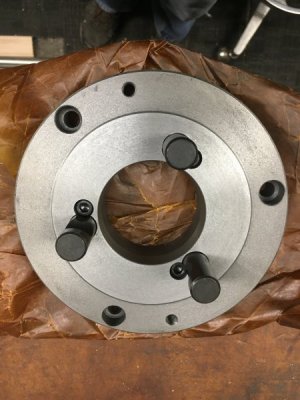Just got a new d1-4 mounting plate for a 6” bison 3jaw I had. I bought a semifinished plate which has a 3 bolt pattern to fasten the chuck to plate. Good thing is the pattern matches my chucks mounting holes but the problem is the existing holes are for a metric screw “to small” and my bison has a six hole pattern.

The problem I’m seeing is trying to align a hole to start.
My thought was center RT then part on RT. Move my distance from center to get hole location. But here’s where it would get goofy. Maybe block part in so that I can loosen part to spin. Then spin plate to align to existing hole. Note measurement. Go back to center of RT check d if moved then go back to measurement and see if it aligns. Then do the 120* and see where it lands. And then somehow time it if off???? Once I get the existing hole pattern aligned it’ll be a snap but getting there is the question.
Or go the simplest but not very precise way. Make transfer screw punches 3 of them and put in the 3 holes needing to be drilled. Then take three screws and put in existing holes to aligned plate to chuck and tighten a touch. The three transfer punches will give me the marks. Then just open up the existing holes and drill the others just off a punch mark on drill press??? Any suggestion would be greatly appreciated. Thanks.

The problem I’m seeing is trying to align a hole to start.
My thought was center RT then part on RT. Move my distance from center to get hole location. But here’s where it would get goofy. Maybe block part in so that I can loosen part to spin. Then spin plate to align to existing hole. Note measurement. Go back to center of RT check d if moved then go back to measurement and see if it aligns. Then do the 120* and see where it lands. And then somehow time it if off???? Once I get the existing hole pattern aligned it’ll be a snap but getting there is the question.
Or go the simplest but not very precise way. Make transfer screw punches 3 of them and put in the 3 holes needing to be drilled. Then take three screws and put in existing holes to aligned plate to chuck and tighten a touch. The three transfer punches will give me the marks. Then just open up the existing holes and drill the others just off a punch mark on drill press??? Any suggestion would be greatly appreciated. Thanks.


